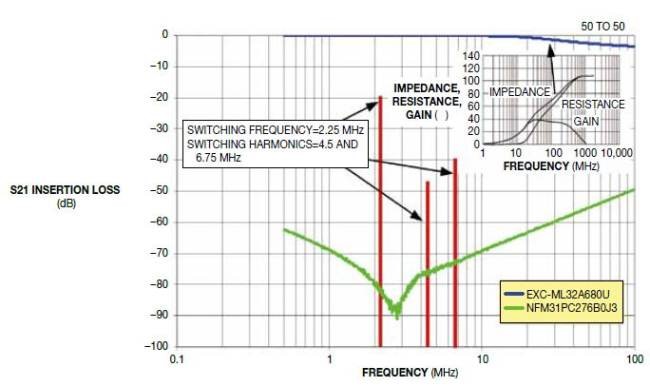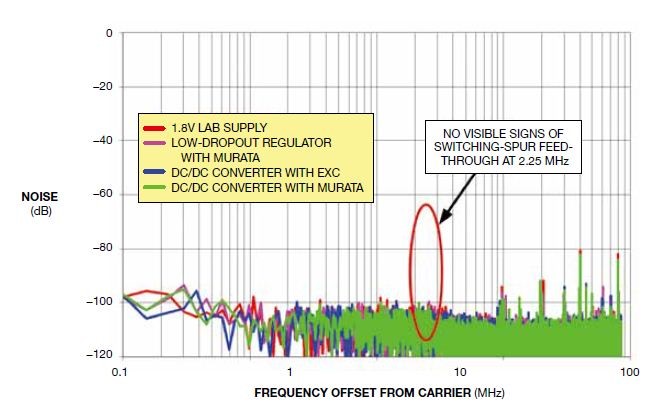 Released:2019-04-01 00:00:49
Released:2019-04-01 00:00:49 Views 1888 次
Views 1888 次 For designers who choose high-speed data converters, power consumption is the most important system design parameter. Whether it's portable designs that require longer battery life or small products that consume less heat, power consumption is crucial. System designers used to use low noise linear regulators to power data converters, such as low-voltage differential regulators, instead of switch regulators, because they were concerned that switch noise would enter the output spectrum of the converter, greatly reducing AC performance.
For designers who choose high-speed data converters, power consumption is the most important system design parameter. Whether it's portable designs that require longer battery life or small products that consume less heat, power consumption is crucial. System designers used to use low noise linear regulators to power data converters, such as low-voltage differential regulators, instead of switch regulators, because they were concerned that switch noise would enter the output spectrum of the converter, greatly reducing AC performance.

For designers selecting high-speed data converters, power consumption is the most critical system design parameter. Whether for portable designs requiring extended battery life or smaller products consuming less thermal energy, power efficiency is paramount. System designers previously used low-noise linear regulators, such as low-dropout (LDO) regulators, to power data converters instead of switch-mode regulators, out of concern that switch noise would infiltrate the converter's output spectrum, significantly degrading AC performance.
However, newer generations of noise-optimized switch-mode regulators (employed in mobile phones) minimize interference with adjacent low-noise amplifiers, prompting a shift in applications. They can directly power high-speed data converters from a DC/DC converter without significantly compromising AC performance. This design immediately raises power efficiency by 20% to 25%.
Modern high-speed converters consume approximately 50% less power than their predecessors, partly due to the reduction of supply voltage from 3.3V to 1.8V. In a design using an LDO regulator, as the power rail drops, the regulator's dropout voltage and the availability of clean power rails become increasingly important for power efficiency. The digital portion of a circuit board typically has numerous voltage rails to provide various core and I/O voltages for FPGAs and processors. In contrast, the analog section may have only a few "clean" voltages available, such as 3.3V and 5V.
For a high-speed data converter, a linear regulator could be employed to derive a 3.3V voltage from a common 5V rail. In this case, the LDO has a 1.7V drop, equating to approximately 35% power loss. When using an LDO (such as CBM41AD49) to supply a 1.8V power to an ADC from a 3.3V bus (Reference 1), the power loss in the linear regulator increases to about 45%, indicating that the LDO dissipates nearly half the power. This example demonstrates how an inefficient power design can easily result in a 50% power loss. Switch-mode regulators' efficiency is largely independent of the input power rail size, thus enabling substantial power savings. With careful design, their impact on AC performance can be minimized.
Power Filtering
A key component in isolating ADC switching noise is the power filter, comprising a ferrite bead and bypass capacitors. Several crucial characteristics should be considered when selecting a ferrite bead. Firstly, the ferrite bead must have a sufficient current rating for the data converter and exhibit a low DC resistance (DCR) to minimize voltage drops across the bead itself. For instance, a 200mA supply through a ferrite bead with a DCR of 1Ω would produce a 200mV drop. This drop could push the ADC voltage to its limits, considering the standard deviation of the supply voltage; the ADC voltage might even fall below the recommended operating voltage.
Secondly, the ferrite bead must exhibit high impedance at both the switch frequency and harmonics of the DC/DC converter to block switching noise and glitches. Most ferrite beads on the market have their impedance specified at 100MHz, whereas modern DC/DC converters typically operate at switch frequencies ranging from 500kHz to 6MHz. In our example, the CBM41AD49 evaluation module employs a TPS625290 switch regulator with a switching frequency of 2.25MHz (Reference 2). Since the DC/DC regulator has a square-wave output, higher-order harmonics must also be taken into account. Murata's NFM31PC276B0J3 EMI filter offers high impedance and low DCR within this frequency range.
Figure 1 compares the insertion loss of a traditional ferrite bead from Murata with an EMI filter having a resistance of 68Ω at 100MHz. The power supply circuit has low impedance, with insertion loss measured in a 50Ω environment. Thus, the insertion loss values for the power filter may differ slightly, although the resonant frequency remains unchanged.

Figure 1 demonstrates that Murata's NFM31PC276B0J3 EMI filter exhibits higher impedance and lower DCR compared to a conventional ferrite bead with a resistance of 68 Ω at 100 MHz.
Other components within the power supply filter are bypass capacitors. When selecting their values, they should be chosen such that their resonant frequency—creating a low-impedance ground path—is close to the switching frequency. In this way, switch noise passing through the ferrite bead is shorted to ground. The power filter insertion loss comparison in Figure 2 shows that the appropriate bypass capacitor values can produce a resonance near the switching frequency, even when used with a traditional ferrite bead like the EXCML32A680. However, at lower frequencies, there is less discernible difference when it is paired with a 0 Ω resistor. On the other hand, the Murata EMI filter provides an additional ≈20 dB attenuation around the switching frequency. The power filter depicted in Figure 3 employs a 33 μF tantalum capacitor for broad-band decoupling, while ceramic capacitors of 10 μF, 2.2 μF, and 0.1 μF have narrower resonant frequencies.

Figure 2 shows that the correct bypass capacitance value can generate a resonance close to FS (switching frequency), even when combined with a traditional ferrite magnetic ring (such as EXC-ML32A680).

Figure 3, this power filter uses a 33 μ F tantalum capacitors perform broadband decoupling, while 10 μ F. 2.2 μ F and 0.1 μ The ceramic capacitor of F has a narrow resonant frequency.
AC performance
According to the PSRR characteristics of the data converter, some noise levels on the power rail can still enter the ADC, reducing AC performance. Figure 4 shows the comparison of SNR and SFDR (no spurious dynamic range) in frequency sweep. One is a reference power supply using a low voltage differential regulator (such as a clean 1.8V laboratory power supply), and the other is a DC/DC converter with different power filter options using a CBM41AD49 evaluation module.

Figure 4, these SNR (a) and SFDR (b) sweep frequency plots compare a reference power supply using a low voltage differential regulator (such as a clean 1.8V laboratory power supply) and a DC/DC converter using a CBM41AD49 evaluation module with different power filter options.
The test results show that at an intermediate frequency of 300MHz, when powered by a switching regulator, the SNR performance is reduced by approximately 0.3dB compared to a low noise low voltage differential regulator. The performance of various SFDR methods is almost the same. By carefully observing the normalized FFT plot (starting from the input signal and depicting the relationship between noise and offset frequency), it is shown that when using a suboptimal EXC ferrite magnetic ring, the background noise in the entire Nyquist region slightly increases without any signs of switching frequency feeding (Figure 5).

Figure 5, a normalized FFT plot (starting from the input signal and depicting the relationship between noise and offset frequency), indicates that when using a suboptimal EXC ferrite magnetic ring, the background noise in the entire Nyquist region slightly increases without any signs of switching frequency feeding.
Power efficiency
The main advantage of replacing linear regulators with DC/DC converters is energy efficiency. In all experiments conducted using the CBM41AD49 evaluation module, an external 3.3V power supply and a common analog power rail were used to supply power to the low-voltage differential regulator and switch regulator, respectively. Table 1 presents the measured power efficiency and their corresponding static currents. This comparison indicates that the power consumption of low-voltage differential voltage regulators is almost always much higher than that of ADCs. The power consumption of the switch regulator is only 32mW higher than an ideal solution, thus achieving an efficient power supply design. When the input voltage is gradually lowered (from 3.3V to 2.5V or 2.2V), the efficiency of the low-voltage differential voltage regulator can be further improved, but higher system costs and larger volume costs need to be paid.
Although the design of DC/DC converters requires more external components with lower voltage differentials, their overall occupying area may be smaller because newer DC/DC converters have higher switching frequencies, greatly reducing the volume of inductance. For example, 33 is required at 500kHz μ H. At 2.25MHz, it only takes about 2.2 μ H.

Table 1: Comparison of Converters
In contrast, linear regulators may not require power filtering but are also subject to size constraints due to their typically higher power dissipation. From a cost perspective, switch-mode regulators might have slightly higher costs because of the larger number of components involved. However, the increased efficiency can offset the expenses associated with heat dissipation techniques and system power budgeting (References 3 & 4).
When system designers pursue higher power efficiency in components, adopting a switch-mode regulator-based power architecture for high-speed data converters can result in substantial energy savings. A switch-mode regulator can directly power a low-power high-speed data converter without significantly compromising its AC performance.
ChipBestMicro has launched the CBM41AD49 fully compatible with the foreign ADS4149.
For any required documentation, please contact the authorized agent.
010-62106066
( Monday to Friday 9:00 - 18:00 )
 704-705, Block D, Building 2, No. 9 Fenghao East Road, Haidian District, Beijing
704-705, Block D, Building 2, No. 9 Fenghao East Road, Haidian District, Beijing

Wechat Public Account